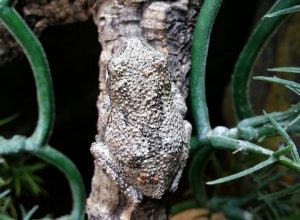Copyright 2021 Evolution Reptiles
All rights reserved.
Copyright 2025 Evolution Reptiles
All rights reserved.
All rights reserved.
This is a small species of tree frog that can be found across the eastern United States and into south-eastern Canada. It is visually almost identical to the Cope’s grey treefrog, but the two are very genetically different, and cannot readily interbreed.
Reaching an adult size of 3.8 to 5cm, the females are usually larger than the males. It is variable in colour, but is typically a mottled grey with females having a white throat, and males having a grey or black throat especially in the breeding season. Young frogs are sometimes green, but turn grey as they approach adulthood.
In common with all tree frogs, the enclosure provided should have lots of climbing surfaces, twigs, and sturdy branches. In the wild these frogs tend to stay high in the canopy except when they come down to breed, so they will appreciate plenty of cover. They are also capable of burrowing to escape temperatures that are high enough to make them uncomfortable, so make sure that any substrate used is suitable for digging.
They do like a high humidity, but there also needs to be adequate ventilation; the conditions in their woodland home are humid but not stagnant, and the setup needs to mirror this. We prefer to use the screen topped glass terrariums, as they are very well ventilated, and when used with the correct substrate and plenty of cover, they hold humidity well. What is even better is a live planted, bioactive environment – if you’ve ever wanted to give that a go, this is an ideal species to begin with!

An enclosure size of 45x45x60cm is suitable for these frogs, and as they are happy to live alone or with company then you could keep up to three frogs in this size setup. Make sure that there are plenty of perching and basking spaces as well as lots of cover so that each frog can get away from any others it lives with. A hot spot temperature of 25 to 28ºC with a background ambient temperature of 20 to 23ºC is ideal, and temperatures can drop as low as 16ºC at night. They can tolerate temperatures slightly higher and lower than this, but will tend to burrow if they are uncomfortable. Never guess your temperatures, always check them with a digital thermometer.
Despite the common internet opinion that ‘frogs don’t need UV’, they really do! Like all treefrog species, they will very much appreciate low levels of UVB over their enclosure. This can be provided by a compact bulb or one of the excellent quality new low output T5 units on the market; as long as plenty of cover is provided your frogs will be much healthier and happier. You will sometimes see your frogs basking, especially first thing in the morning; they regulate their own exposure, and use the energy to metabolise the calcium in their diet. Not only is this a more natural system for them, it’s much kinder, too.
Feeding is, as with most amphibians, relatively simple. They will eat anything they can fit in their mouths although they do appear to have a preference for smaller prey; crickets, locusts, soldier flies, waxmoths, waxworms and mealworms should all be taken. Remember to gut load your feeder insects, and always use a good quality calcium or multivitamin/multimineral powder to dust them with just before feeding.
Simple to keep and attractive to look at, this charming little treefrog is definitely worth keeping if you are looking for something a little bit different!
Copyright 2021 Evolution Reptiles
All rights reserved.